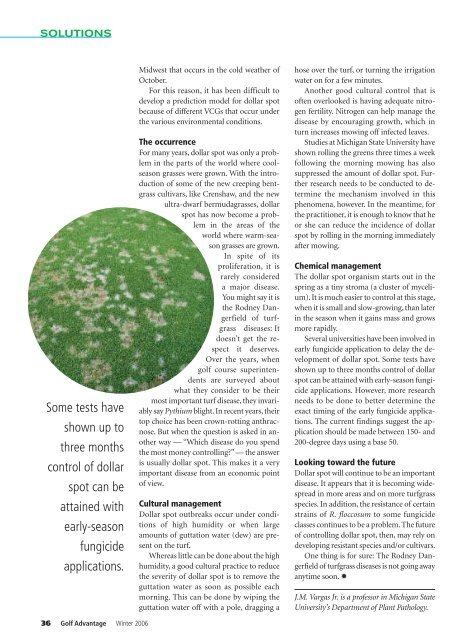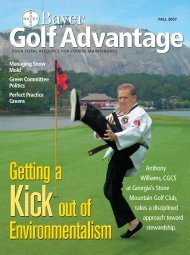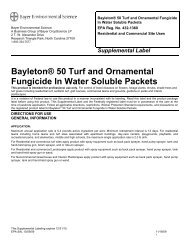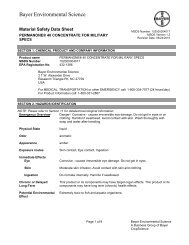Mike Coker and son Troy work on golf courses ... - Backed By Bayer
Mike Coker and son Troy work on golf courses ... - Backed By Bayer
Mike Coker and son Troy work on golf courses ... - Backed By Bayer
You also want an ePaper? Increase the reach of your titles
YUMPU automatically turns print PDFs into web optimized ePapers that Google loves.
SOLUTIONS<br />
Some tests have<br />
shown up to<br />
three m<strong>on</strong>ths<br />
c<strong>on</strong>trol of dollar<br />
spot can be<br />
attained with<br />
early-sea<str<strong>on</strong>g>s<strong>on</strong></str<strong>on</strong>g><br />
fungicide<br />
applicati<strong>on</strong>s.<br />
Midwest that occurs in the cold weather of<br />
October.<br />
For this rea<str<strong>on</strong>g>s<strong>on</strong></str<strong>on</strong>g>, it has been difficult to<br />
develop a predicti<strong>on</strong> model for dollar spot<br />
because of different VCGs that occur under<br />
the various envir<strong>on</strong>mental c<strong>on</strong>diti<strong>on</strong>s.<br />
The occurrence<br />
For many years, dollar spot was <strong>on</strong>ly a problem<br />
in the parts of the world where coolsea<str<strong>on</strong>g>s<strong>on</strong></str<strong>on</strong>g><br />
grasses were grown. With the introducti<strong>on</strong><br />
of some of the new creeping bentgrass<br />
cultivars, like Crenshaw, <str<strong>on</strong>g>and</str<strong>on</strong>g> the new<br />
ultra-dwarf bermudagrasses, dollar<br />
spot has now become a problem<br />
in the areas of the<br />
world where warm-sea<str<strong>on</strong>g>s<strong>on</strong></str<strong>on</strong>g><br />
grasses are grown.<br />
In spite of its<br />
proliferati<strong>on</strong>, it is<br />
rarely c<strong>on</strong>sidered<br />
a major disease.<br />
You might say it is<br />
the Rodney Dangerfield<br />
of turfgrass<br />
diseases: It<br />
doesn’t get the respect<br />
it deserves.<br />
Over the years, when<br />
<strong>golf</strong> course superintendents<br />
are surveyed about<br />
what they c<strong>on</strong>sider to be their<br />
most important turf disease, they invariably<br />
say Pythium blight. In recent years, their<br />
top choice has been crown-rotting anthracnose.<br />
But when the questi<strong>on</strong> is asked in another<br />
way — “Which disease do you spend<br />
the most m<strong>on</strong>ey c<strong>on</strong>trolling?” — the answer<br />
is usually dollar spot. This makes it a very<br />
important disease from an ec<strong>on</strong>omic point<br />
of view.<br />
Cultural management<br />
Dollar spot outbreaks occur under c<strong>on</strong>diti<strong>on</strong>s<br />
of high humidity or when large<br />
amounts of guttati<strong>on</strong> water (dew) are present<br />
<strong>on</strong> the turf.<br />
Whereas little can be d<strong>on</strong>e about the high<br />
humidity, a good cultural practice to reduce<br />
the severity of dollar spot is to remove the<br />
guttati<strong>on</strong> water as so<strong>on</strong> as possible each<br />
morning. This can be d<strong>on</strong>e by wiping the<br />
guttati<strong>on</strong> water off with a pole, dragging a<br />
hose over the turf, or turning the irrigati<strong>on</strong><br />
water <strong>on</strong> for a few minutes.<br />
Another good cultural c<strong>on</strong>trol that is<br />
often overlooked is having adequate nitrogen<br />
fertility. Nitrogen can help manage the<br />
disease by encouraging growth, which in<br />
turn increases mowing off infected leaves.<br />
Studies at Michigan State University have<br />
shown rolling the greens three times a week<br />
following the morning mowing has also<br />
suppressed the amount of dollar spot. Further<br />
research needs to be c<strong>on</strong>ducted to determine<br />
the mechanism involved in this<br />
phenomena, however. In the meantime, for<br />
the practiti<strong>on</strong>er, it is enough to know that he<br />
or she can reduce the incidence of dollar<br />
spot by rolling in the morning immediately<br />
after mowing.<br />
Chemical management<br />
The dollar spot organism starts out in the<br />
spring as a tiny stroma (a cluster of mycelium).<br />
It is much easier to c<strong>on</strong>trol at this stage,<br />
when it is small <str<strong>on</strong>g>and</str<strong>on</strong>g> slow-growing, than later<br />
in the sea<str<strong>on</strong>g>s<strong>on</strong></str<strong>on</strong>g> when it gains mass <str<strong>on</strong>g>and</str<strong>on</strong>g> grows<br />
more rapidly.<br />
Several universities have been involved in<br />
early fungicide applicati<strong>on</strong> to delay the development<br />
of dollar spot. Some tests have<br />
shown up to three m<strong>on</strong>ths c<strong>on</strong>trol of dollar<br />
spot can be attained with early-sea<str<strong>on</strong>g>s<strong>on</strong></str<strong>on</strong>g> fungicide<br />
applicati<strong>on</strong>s. However, more research<br />
needs to be d<strong>on</strong>e to better determine the<br />
exact timing of the early fungicide applicati<strong>on</strong>s.<br />
The current findings suggest the applicati<strong>on</strong><br />
should be made between 150- <str<strong>on</strong>g>and</str<strong>on</strong>g><br />
200-degree days using a base 50.<br />
Looking toward the future<br />
Dollar spot will c<strong>on</strong>tinue to be an important<br />
disease. It appears that it is becoming widespread<br />
in more areas <str<strong>on</strong>g>and</str<strong>on</strong>g> <strong>on</strong> more turfgrass<br />
species. In additi<strong>on</strong>, the resistance of certain<br />
strains of R. floccosum to some fungicide<br />
classes c<strong>on</strong>tinues to be a problem. The future<br />
of c<strong>on</strong>trolling dollar spot, then, may rely <strong>on</strong><br />
developing resistant species <str<strong>on</strong>g>and</str<strong>on</strong>g>/or cultivars.<br />
One thing is for sure: The Rodney Dangerfield<br />
of turfgrass diseases is not going away<br />
anytime so<strong>on</strong>. ✹<br />
J.M. Vargas Jr. is a professor in Michigan State<br />
University’s Department of Plant Pathology.<br />
36 Golf Advantage Winter 2006







